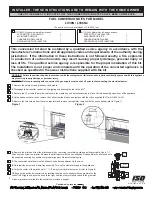
FP15 & FP15A Waterloo - Installation and Operation Manual
61
7.10
Supply of Combustion Air
Legally, it is not mandatory to connect your fireplace to a fresh air intake unless it is required by the local
code or the manufacturer. However, if you want to meet the Novo Climate or R2000 requirements, an
external air intake will be required. The fresh air intake promotes proper combustion and prevents the risk
of house depressurization. Although the external air supply is not a guarantee against the risk of smoke
return caused by house depressurization, it will certainly minimize the risk.
NOTE
•
IT IS STRONGLY RECOMMENDED TO INSTALL A MECHANICAL DAMPER TO CLOSE THE FRESH AIR INTAKE
WHEN THE FIREPLACE IS NOT IN USE.
•
IT IS STRONGLY RECOMMENDED TO INSTALL A CARBON MONOXIDE (CO) DETECTOR/ALARM IN THE ROOM
WHERE THE FIREPLACE IS INSTALLED. THE CO DETECTOR WILL WARN YOU IF, FOR ANY REASON, THE WOOD
FIREPLACE FAILS TO FUNCTION CORRECTLY.
The easiest and most reliable supply of combustion air for your wood fireplace is from the room in which it
is installed. The room air is already preheated so it will not cool the fire and its availability is not affected by
the pressure of the wind on the house. However, the combustion of wood requires a large volume of air. It
will take only a few hours to consume the equivalent of the entire volume of air contained inside your
home. This air will be replaced by new cold air from outside either through tiny cracks in your home or via
your air exchanger. It is strongly recommended to install an external air intake to increase your heating
efficiency and to avoid consuming the preheated air you already paid for.
Some states or counties require that fireplace are connected to a fresh air intake. If you install a fresh air
intake on an external wall, its pressure may vary in windy conditions. It would be therefore preferable not
to install the air intake on a heavily windward wall. If you experience difficulties with your fireplace and you
suspect strong winds as the source of the problem, a mechanical damper with help you diagnose and solve
the problem. Check the outdoor air duct for soot deposits when the venting system is cleaned and
inspected.
Summary of Contents for Waterloo FP15
Page 10: ...10 FP15 FP15A Waterloo Installation and Operation Manual 2 3 Measurements FP15 ...
Page 11: ...FP15 FP15A Waterloo Installation and Operation Manual 11 ...
Page 12: ...12 FP15 FP15A Waterloo Installation and Operation Manual 2 4 Measurements FP15A ...
Page 13: ...FP15 FP15A Waterloo Installation and Operation Manual 13 ...
Page 77: ...FP15 FP15A Waterloo Installation and Operation Manual 77 ...
Page 87: ...NOTES ...
Page 88: ...88 FP15 FP15A Waterloo Installation and Operation Manual ...
Page 89: ......
















































